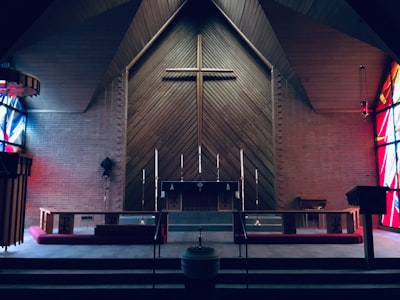Key Highlights
- SEO helps churches improve online visibility and reach people looking for a spiritual home- Local SEO is essential for churches, as it focuses on optimizing websites to rank well in local searches.
- Churches can benefit from strategies such as keyword research, content marketing, and local citations to improve their SEO.
- Responsive design and mobile optimization are crucial for churches, as more people are using mobile devices to search for information.
- Monitoring and measuring SEO success through analytics is important for churches to make adjustments and improve their strategies.
- Utilizing social media and encouraging community engagement can also contribute to better SEO for churches.
Introduction
In today’s digital age, it’s crucial for churches to have a strong online presence. With more people turning to the internet to search for churches and spiritual guidance, it’s important for churches to optimize their websites for search engines. This is where Search Engine Optimization comes in. SEO helps churches improve their visibility in search engine results, making it easier for people to find and connect with them.
In this beginner’s guide to SEO for churches, we will explore the basics of SEO, why it matters for churches, and how churches can get started with their SEO efforts. We will cover key SEO terms, steps to begin with SEO, and on-page and off-page SEO strategies specifically tailored for churches. Additionally, we will discuss the importance of local SEO and how churches can connect with their local community through SEO.
Whether you are just starting with SEO or looking to improve your existing strategies, this guide will provide you with the knowledge and tools necessary to enhance your church’s online visibility and reach more people in need of spiritual guidance. Let’s dive in!
Understanding the Basics of SEO for Churches

Search Engine Optimization (SEO) is the practice of optimizing a website to improve its visibility in search engine results. For churches, SEO involves making changes to their church’s website and online presence to ensure that they show up in search results when people are looking for churches or spiritual guidance. Church SEO focuses on optimizing the website and its content to reach the target audience effectively. By implementing SEO strategies, churches can increase their visibility and attract more visitors to their websites and physical locations, making it essential to understand the basics of SEO for churches and how it can improve your church’s website. On-Page SEO, specifically, involves using appropriate keywords, optimizing meta tags, creating quality content, and ensuring your site’s usability. This form of SEO is about making each page on your church’s website an entry point for potential visitors, helping them find exactly what they’re looking for – be it service times, community events, or spiritual guidance.
Why SEO Matters for Your Church
SEO is crucial for churches because it helps them appear in search results when people are actively looking for spiritual guidance or a church community. When a church ranks higher in search results, it increases its chances of attracting more visitors and potential members. This is especially important in today’s digital age, where people rely heavily on search engines to find information and make decisions. By investing in SEO, church leaders can improve their online visibility, reach a wider audience, and effectively market their services and programs. It also helps churches enhance their website visitors’ experience by providing them with relevant and engaging content that meets their needs and interests.
Key SEO Terms Every Church Should Know
- Search Engine: A search engine is a software system that enables users to search for information on the internet. Some popular search engines include Google, Bing, and Yahoo.
- Keyword Research: Keyword research is the process of identifying the words and phrases that people use when searching for information related to a specific topic. It helps churches understand what their target audience is looking for and optimize their website accordingly.
- Meta Tags: Meta tags are snippets of text that provide information about a web page’s content. They appear in the HTML code of a webpage but are not visible to website visitors. Meta tags include meta titles, meta descriptions, and meta keywords. They play a crucial role in optimizing a website for search engines.
- Backlinks: Backlinks are links from other websites that point to a specific webpage. They are important for SEO because they act as votes of confidence for a website, indicating to search engines that the website is reputable and trustworthy.
- On-Page SEO: On-Page SEO refers to the optimization of individual web pages to improve their search engine rankings. It includes optimizing content, meta tags, headings, and other elements on a webpage.
- Off-Page SEO: Off-Page SEO refers to activities that are done outside of a website to improve its search engine rankings. This includes link building, social media marketing, and other strategies that help build the website’s reputation and authority.
- Local SEO: Local SEO focuses on optimizing a website for local search results. It helps businesses and organizations, including churches, connect with their local community and attract local visitors and members.
How to Begin with SEO for Churches

To begin with SEO for your church, it’s important to assess your current online presence and set specific goals for your SEO efforts. Start by evaluating your church’s website and identifying areas for improvement, such as website design, user experience, and content quality. Next, focus on local SEO to connect with your local community and attract visitors in your area. This can involve claiming and optimizing your Google My Business listing, utilizing local keywords and content, and encouraging positive reviews and community engagement. Finally, monitor and adjust your SEO strategy regularly to ensure ongoing success and improvement.
Assessing Your Current Online Presence
Assessing your current online presence is an important first step in your SEO journey. Start by analyzing your website’s performance using tools like Google Analytics. This will provide valuable insights into your website traffic, user behavior, and conversion rates. Pay attention to metrics such as bounce rate, average time on page, and the number of conversions or inquiries generated through your website.
Evaluate your website design and user experience. Is your website visually appealing, easy to navigate, and mobile-friendly? Ensure that your website is optimized for all devices, as an increasing number of people access the internet through their smartphones or tablets.
Additionally, review the content on your website. Is it relevant, informative, and engaging? Consider conducting a content audit to identify any gaps or areas for improvement. By assessing your current online presence, you can identify areas that need enhancement and develop a plan to optimize your website for better SEO performance.
Setting Up Your SEO Goals
Setting clear and measurable SEO goals is essential for the success of your church’s SEO efforts. Start by identifying your target audience and understanding their needs and preferences. This will help you tailor your SEO strategy to attract the right visitors and potential members.
One common goal for churches is to rank on the first page of search engine results for relevant keywords. This increases visibility and the likelihood of attracting more organic traffic. However, it’s important to set realistic goals based on your church’s size, location, and competition.
Other goals could include increasing website traffic, improving conversion rates, or increasing engagement on social media platforms. Whatever goals you set, ensure they are specific, measurable, attainable, relevant, and time-bound (SMART). Regularly monitor your progress and make adjustments to your SEO strategy as needed to achieve your goals.
The Beginner’s Guide to Church SEO

In the beginner’s guide to church SEO, we will provide you with the essential information and strategies to improve your church’s online visibility and reach. We will walk you through the process of optimizing your church’s website for search engines, focusing on local SEO to connect with your local community. From claiming and optimizing your church’s Google My Business listing to utilizing local church SEO keywords and creating relevant content, we will cover the key steps and best practices for church SEO. By the end of this guide, you will have a solid foundation to begin implementing SEO strategies for your church and reaching more people in your particular location.
What You Need to Get Started

Before diving into church SEO, there are a few essential tools and resources you should have to get started. One popular tool for SEO optimization is Rank Math SEO, a WordPress plugin that helps you optimize your website’s content for search engines. It provides recommendations for improving your website’s SEO and ensures that your content is well-structured and keyword-optimized.
Additionally, having a clear understanding of your church’s upcoming events and programs is crucial for effective SEO. By promoting these events on your website and optimizing the content, you can attract more visitors and generate interest in your church community.
Finally, focusing on providing a good user experience is essential for SEO success. Ensure that your website is visually appealing, easy to navigate, and optimized for mobile devices. By creating a seamless and user-friendly experience, you can keep visitors on your website longer and encourage them to explore more of what your church has to offer, ultimately leading to a better user experience for those visiting for the first time.
Step 1: Keyword Research for Churches
se
Keyword research is a crucial step in optimizing your church’s website for search engines. Start by identifying relevant keywords that your target audience is likely to search for when looking for a new church or spiritual guidance. These keywords can give you a good idea of the phrases people use to find churches near them, such as “church near me,” “spiritual community,” “new church,” or specific denominational keywords. Then, you can create content about these topics to attract visitors!
Once you have a list of relevant keywords, incorporate them strategically into your website’s content, page titles, meta descriptions, and headings. This will help search engines understand the focus and relevance of your website. However, it’s important to avoid overusing keywords, as this can be seen as spammy by search engines and negatively impact your SEO efforts. Use keywords naturally and focus on providing valuable and engaging content for your website visitors. Remember, HTML is the gold standard for developing websites and includes important SEO elements like title tags, meta descriptions, and alt tags.
Step 2: Optimizing Your Church Website Structure
Optimizing your church’s website structure is an important step in improving its SEO performance. Start by ensuring that your website is mobile-friendly, as more people are using mobile devices to access the internet. A responsive church website design will ensure that your website adapts to different screen sizes and provides a seamless user experience. Don’t forget to include location details on your website, such as your address and maps, to make it easy for people to find and visit your church.
Next, focus on optimizing your website URL structure. Use descriptive and keyword-rich URLs that accurately reflect the content of each page. This helps search engines understand the context and relevance of your website content.
Consider organizing your website into relevant sections and creating a logical navigation menu. This will make it easier for visitors to find the information they are looking for and navigate your website effortlessly. A well-structured website enhances the user experience and improves your website’s SEO performance.
Step 3: Creating Content That Engages and Ranks
Creating high-quality and engaging content is essential for both user experience and SEO. Start by identifying relevant topics and themes that are of interest to your target audience. This can include sermons, educational articles, event announcements, and inspirational stories.
Ensure that your content is well-written, informative, and keyword optimized. Incorporate relevant keywords naturally into your content to improve its visibility in search engine rankings. However, avoid keyword stuffing, as this can negatively impact your website’s SEO.
Consider incorporating a blog section on your website to regularly publish new and fresh content. This not only attracts visitors but also provides an opportunity for your content to rank higher in search engine results. Regularly update your blog with valuable and relevant new content to keep your website active and engaging for visitors.
Step 4: Building Links Within Your Church Community
Building links within your church community can significantly improve your website’s SEO. Start by reaching out to other churches, religious organizations, and community groups in your area and offer to collaborate on events or projects. This can lead to opportunities for cross-promotion and the exchange of backlinks, which are seen as “votes of confidence” by search engines. Additionally, creating excellent resources for your place of worship can also attract links from relevant outlets, churches, or organizations. This is a crucial addition to your church’s SEO strategy, and if done well, can greatly benefit your website’s online reputation and authority.
Additionally, consider hosting or participating in local community events and fundraisers. This can generate publicity and attract more visitors to your website, increasing your chances of earning backlinks from local media outlets or community websites.
Encourage your church members to share your website and content on social media platforms, as this can also help generate backlinks and increase your website’s visibility.
Step 5: Monitoring and Adjusting Your SEO Strategy

Monitoring and adjusting your SEO strategy on a regular basis is essential for ongoing success. Keep track of your website’s performance using tools like Google Search Console and Google Analytics. These tools provide valuable insights into your website’s traffic, keywords, and user behavior.
Regularly review your website’s analytics and identify areas for improvement. Are there specific pages or keywords that are performing well? Are there any pages that have a high bounce rate or low engagement?
Based on your findings, make adjustments to your SEO strategy as needed. This can include updating content, optimizing meta tags, improving website speed, or enhancing user experience. SEO is an ongoing process, and staying proactive and adaptable will help you stay ahead of the competition and continue attracting visitors to your church website.
On-Page SEO Essentials for Churches
On-page SEO refers to optimizing individual web pages to improve their visibility and rankings in search engine results. For churches, there are several essential aspects of on-page SEO to focus on.
Firstly, ensure that your meta descriptions are well-written and accurately describe the content of each page. Meta descriptions appear in search engine results, providing users with a preview of what they can expect from your website.
Secondly, optimize your title tags by including relevant keywords. Title tags are the clickable headlines that appear in search engine results and are important for both users and search engines.
Lastly, create high-quality and relevant content that meets the needs and interests of your target audience. Incorporate relevant keywords naturally and provide valuable information that engages and informs your website visitors.
Crafting Meta Tags That Attract Clicks

Meta tags play a crucial role in attracting clicks from search engine results and provide important information about a web page’s content. Crafting compelling and informative meta tags is essential for improving your church’s visibility and enticing users to click through to your website.
Ensure that your meta tags accurately describe the content of each page and incorporate relevant keywords. Use action-oriented language and provide a clear and concise summary of what users can expect when they visit your website.
Avoid generic or duplicate meta tags, as these can negatively impact your website’s SEO. Craft unique and engaging meta tags for each page to increase the chances of attracting clicks and driving more traffic to your church website.
Utilizing Headings and Subheadings Effectively
Headings and subheadings play a crucial role in organizing and structuring your website’s content. Effective use of headings and subheadings not only improves the user experience but also helps search engines understand the hierarchy and relevance of your content.
Use descriptive and keyword-rich headings and subheadings to break up your content and make it more scannable for users. This helps visitors quickly find the information they are looking for and encourages them to stay on your website longer.
Ensure that your headings and subheadings accurately reflect the content of each section and incorporate relevant keywords naturally. This will make it easier for search engines to understand and rank your web pages, improving your website’s visibility in search engine results.
Importance of Mobile Optimization

Mobile optimization is crucial for churches, as more people are using mobile devices to access the internet and search for information. A mobile-friendly website ensures that your content is easily accessible and readable on various screen sizes, providing a seamless user experience.
Optimize your website for mobile devices by using responsive design, which automatically adjusts the layout and content based on the device used. This eliminates the need for separate mobile and desktop versions of your website and ensures a consistent experience for all users.
Mobile optimization is not only important for user experience but also for SEO. Google considers mobile-friendliness as a ranking factor, meaning that a mobile-optimized website is more likely to rank higher in search engine results.
Off-Page SEO Strategies for Churches
Off-page SEO strategies are crucial for churches to improve their online visibility and increase their website’s authority. Off-page SEO refers to optimization techniques that are implemented outside of a website to improve its visibility and reputation. Here are a few off-page SEO strategies that churches can implement:
- Leveraging social media for better visibility: Actively engage with your community on social media platforms to increase brand awareness, foster relationships, and drive traffic to your website.
- Encouraging community engagement and reviews: Encourage your community members to leave positive reviews and testimonials on platforms like Google My Business and social media. Positive reviews can improve your online reputation and attract more visitors.
- Utilizing local SEO techniques: Implement local SEO strategies, such as claiming and optimizing your Google My Business listing, utilizing local keywords, and creating content that is relevant to your local community.
By implementing these off-page SEO strategies, churches can improve their online visibility, increase their website’s authority, and attract more visitors to their website.
Leveraging Social Media for Better Visibility

Social media platforms provide churches with an excellent opportunity to increase their online visibility, engage with their community, and drive traffic to their website. By actively leveraging social media, churches can improve their brand awareness, foster relationships with their community members, and attract more visitors to their website. Here are some tips for leveraging social media for better visibility:
- Identify your target audience: Understand who your target audience is and which social media platforms they are most active on. This will help you focus your efforts on the platforms that are most relevant to your church.
- Create engaging content: Develop high-quality and engaging content that is tailored to your target audience. This could include sharing inspiring messages, promoting church events, sharing informative articles, or showcasing community outreach initiatives.
- Engage with your community: Actively engage with your community by responding to comments, answering questions, and fostering conversations. This can help build relationships and encourage community members to share your content with their networks.
- Utilize social media advertising: Consider utilizing social media advertising to reach a wider audience and promote your church’s content and events. Platforms like Facebook and Instagram offer advanced targeting options to ensure that your ads are seen by the right audience.
By leveraging social media effectively, churches can increase their online visibility, engage with their community, and drive more traffic to their website.
Encouraging Community Engagement and Reviews
Encouraging community engagement and reviews is a valuable off-page SEO strategy for churches. By actively engaging with your community and encouraging them to leave positive reviews, churches can improve their online reputation, attract more visitors, and increase their website’s authority. Here are some tips for encouraging community engagement and reviews:
- Foster relationships with your community members: Actively engage with your community on social media, respond to comments and messages, and foster conversations. This helps build relationships and encourages community members to support your church.
- Encourage positive reviews and testimonials: Ask your community members to leave positive reviews and testimonials on platforms like Google My Business, Facebook, and Yelp. Positive reviews can improve your online reputation and attract more visitors.
- Provide excellent customer service: Provide exceptional customer service to your community members both online and offline. This includes responding promptly to inquiries and addressing any concerns or issues promptly and professionally.
By encouraging community engagement and positive reviews, churches can improve their online visibility, strengthen their reputation, and attract more visitors to their website.
Technical SEO: A Checklist for Churches
Technical SEO is an important aspect of optimizing a church’s website for search engines and improving its visibility in search results. By implementing technical SEO best practices, churches can ensure that their website is easily accessible, user-friendly, and optimized for search engines. Here is a checklist for churches to ensure technical SEO:
- Ensuring fast loading times: Optimize your website’s loading speed by optimizing images, reducing file sizes, and leveraging browser caching.
- Implementing secure browsing (HTTPS): Secure your website by implementing HTTPS, which provides a secure and encrypted connection for users.
- Optimizing website URLs: Use user-friendly and descriptive URLs that are easy to read and understand.
By prioritizing technical SEO, churches can improve their website’s visibility, user experience, and search engine rankings.
Ensuring Fast Loading Times

Fast loading times are crucial for both user experience and search engine optimization (SEO) for churches. When a website takes too long to load, visitors are more likely to leave and find another church website that offers a better experience. This can result in a high bounce rate and lower search engine rankings. To ensure fast loading times, churches should optimize their website by compressing images, minifying CSS and JavaScript files, and reducing server response time. Additionally, choosing a reliable hosting provider and using content delivery networks (CDNs) can further improve website speed. By prioritizing fast loading times, churches can provide a positive user experience and increase their chances of ranking higher in search engine results.
Implementing Secure Browsing (HTTPS)
Implementing secure browsing through HTTPS is not only important for protecting user data but also for improving SEO for churches. HTTPS encrypts the connection between a website and its visitors, ensuring that any information exchanged is secure. Search engines like Google prioritize websites with HTTPS in their rankings, as it provides a safer browsing experience for users. To implement HTTPS, churches can obtain an SSL certificate from a trusted certificate authority and configure their website to use HTTPS. It is also important to update any internal links and ensure that all resources, such as images and scripts, are loaded securely. By implementing secure browsing, churches can enhance their website’s security, gain the trust of visitors, and improve their SEO rankings.
Local SEO: Connecting with Your Community

Local SEO plays a crucial role in helping churches connect with their local community. By optimizing their online presence for local search, churches can increase their visibility to people searching for religious services in their area. One important step is claiming and optimizing their Google My Business listing, as well as creating listings on other major directories like Bing Places for Business and Yelp. This allows churches to provide accurate and up-to-date information such as location, contact details, and service times. Additionally, utilizing local directories and keywords and creating content that is relevant to the local community can further improve a church’s visibility in local search results. By focusing on local SEO strategies, churches can attract more visitors and strengthen their connection with the community.
Claiming and Optimizing Your Google My Business Listing
Claiming and optimizing your Google My Business listing is a crucial step in improving your church’s local SEO. Google My Business allows you to create a profile for your church, providing important information such as your address, phone number, website URL, and service times. This information is displayed in local search results and on Google Maps, making it easier for people in your local area to find and contact your church. To optimize your Google My Business listing, make sure to fill out all the relevant fields, add high-quality photos, and encourage positive reviews from your congregation. Regularly updating your listing with any changes or upcoming events can also help attract more visitors to your church. By claiming and optimizing your Google Business profile, formerly known as Google My Business, you can increase your church’s visibility in local search results and connect with people in your community by providing them with essential details about your church.
Utilizing Local Keywords and Content

Utilizing local keywords and creating relevant content, also known as quality content, is essential for churches to improve their local SEO. Local keywords are specific terms or phrases that people in your community use when searching for religious services or events. By incorporating these keywords into your website’s content, such as page titles, headings, and meta descriptions, you can increase your chances of appearing in local search results. Additionally, creating quality content that is relevant to your local community, such as blog posts or event announcements, can attract more visitors to your website and increase engagement. It’s important to regularly update your website with fresh and valuable content that addresses the needs and interests of your local audience. By utilizing local keywords and creating quality content, churches can enhance their local SEO and better connect with their community.
Conclusion
In conclusion, embracing SEO practices can significantly benefit churches by increasing their online visibility and engagement with the community. By understanding key SEO terms, conducting keyword research, optimizing website structure, creating engaging content, and building local connections, churches can enhance their digital presence. Monitoring and adjusting the SEO strategy is crucial for long-term success. Remember, SEO is a continuous process that requires dedication and effort, but the results are well worth it in reaching and connecting with a broader audience interested in what your church has to offer.
Frequently Asked Questions
How can churches benefit from implementing SEO strategies?
By implementing SEO strategies, churches can increase online visibility, attract new members, share their message with a larger audience, and engage with the community more effectively. This can lead to higher attendance at services, improved outreach efforts, and a stronger online presence for the church.
How Long Does It Take to See SEO Results for Churches?
The time it takes to see SEO results for churches can vary depending on several, such as the competitiveness of your target keywords, the quality of your website content, and the consistency of your SEO efforts. It’s important to remember that SEO is an ongoing process that requires regular maintenance and improvement. Monitoring your website’s performance on a regular basis and making adjustments as needed will contribute to long-term SEO success for your church.
Can Small Churches Compete in SEO?
Yes, small churches can compete in SEO by focusing on local search results and tailoring their SEO strategies to their specific target audience. By implementing local SEO techniques, such as optimizing their Google My Business listing, utilizing local keywords, and creating localized content, small churches can improve their online visibility and attract visitors in their local area.
How Can Churches Measure Their SEO Success?
Churches can measure their SEO success by tracking key metrics such as website traffic, bounce rate, time on page, and conversion rates. Tools like Google Analytics provide valuable insights into website performance and user behavior, allowing churches to assess the impact of their SEO efforts, identify areas for improvement, and make data-driven decisions to optimize their website and content.



